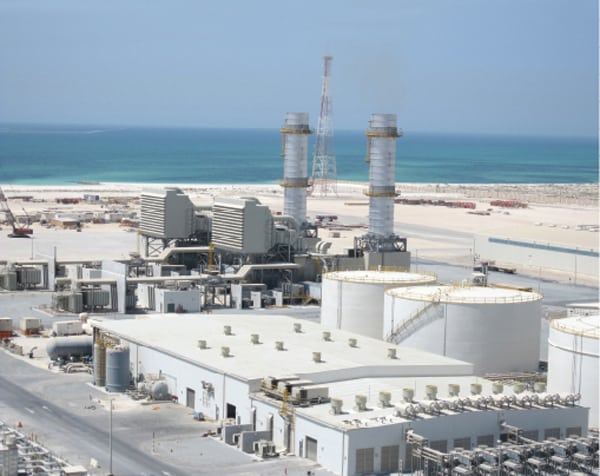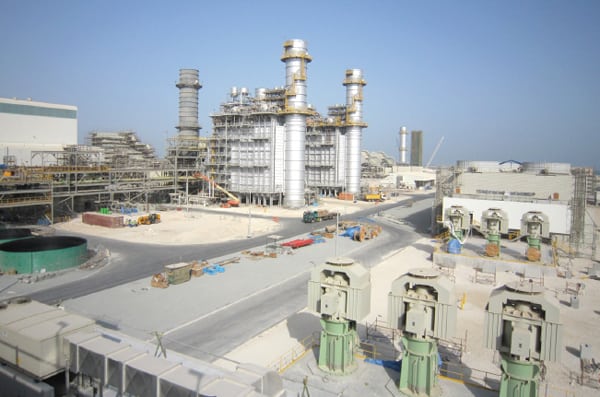Top Plant: Emirates Aluminum Smelter Complex (EMAL), Al-Taweelah, Abu Dhabi, United Arab Emirates
 |
| Courtesy: SNC Lavalin |
Owners/operators: Mubadala Development Co. and Dubai Aluminum
The new 2,100-MW Phase 1 EMAL combined cycle power plant provides dedicated power with a high level of reliability to the Emirates Aluminum Smelter Complex, which is designed to be the world’s largest aluminum smelter upon completion. Located on the Persian Gulf, the gas-fired combined cycle plant uses seawater cooling towers to eliminate thermal stress on local marine life.
The United Arab Emirates (UAE) is a country of contradictions, where the traditional bedouin lifestyle and customs are maintained alongside energetic Western-style business development that includes five-star hotels and world-class shopping areas. Since the discovery of oil in the UAE more than 30 years ago, the UAE has undergone a profound transformation from a region of small desert principalities into a modern state with a high standard of living.
With a growing national population of more than 4.6 million, the UAE has an increased need for electricity both for its residents and its industries. For example, due to an estimated 11% increase in power demand, the emirate of Abu Dhabi is expected to spend nearly $12 billion in developing new water and electricity projects over the next five years.
Contributing to the expanding UAE industrial base, Emirates Aluminum Ltd. (EMAL) has initiated the design and construction of a new world-class greenfield aluminum smelter complex. The Emirates Aluminum Smelter Complex is located on a 6-square-kilometer (15.5-square-mile) site in the Khalifa Port and Industrial Zone in Al-Taweelah, approximately halfway between the cities of Abu Dhabi and Dubai.
The smelter complex is designed to be self-reliant for all of its utility requirements. The sole source of its electrical power will be the 3,650-MW EMAL Power Plant, which is being built in two phases. The 2,100-MW Phase 1 of this combined cycle power plant was recently completed.
Facility Overview
The EMAL 2,100-MW Phase 1 dual-fuel combined cycle power plant is designed to provide dedicated power to the aluminum smelter with an N-2 reliability criterion. Generation outage planning used by the smelter requires that the full capacity be available under N-2 conditions during the winter months and under N-1 conditions during summer months. “N” refers to the number of installed power generation units, while N-1 or N-2 signifies that one or two of the largest generators are out of service. N-2 assumes that one gas or steam turbine is out of service for maintenance, and coincidentally an additional forced outage of a second gas or steam turbine occurs.
Phase 1 of this plant consists of three power blocks, two combined cycle power blocks in a 2 x 1 configuration of combustion turbine generators to steam turbine generator, complete with integral heat recovery steam generators (HRSGs) and bypass stacks for simply cycle operation, and one simple cycle block consisting of two combustion turbines. The two combined cycle power blocks are coupled together on the steam system, so steam from any of the four HRSGs can supply the two steam generators (Figure 1).
 |
| 1. Powering a more diverse economy. Located on the Persian Gulf, the gas-fired combined cycle plant uses seawater cooling towers to eliminate thermal stress on local marine life. Courtesy: SNC-Lavalin |
More specifically, the Phase 1 power plant includes:
- Six General Electric (GE) frame 9FA combustion turbines.
- Generators with dry low-NOx–type combustors for emissions control.
- Four two-pressure, multi-drum HRSGs manufactured by Doosan.
- Two multi-cylinder, two-pressure, induction-condensing-type steam turbine generators without reheat.
- A seawater intake pumping station.
- Water and wastewater systems, including desalination plant and mixed bed demineralizer.
- The main cooling system (seawater cooling towers by SPIG S.p.A.).
- A condenser (Doosan as sub-supplier to GE).
- A GE digital control system.
- Fuel systems consisting of natural gas as the primary fuel and liquid distillate fuel oil as a secondary backup fuel.
With successful completion of Phase I, the EMAL Smelter Complex now has a production capacity of 700,000 metric tons of primary aluminum per year. The product mix includes standard ingots and bill and sheet ingots, through the utilization of DX Technology. DX Technology is a proprietary aluminum smelting technology that offers improved productivity, capacity, and efficiency while maintaining the highest standards of environmental conservation. Currently, the EMAL Smelter Complex consists of 756 reduction cells arranged in two pot lines; the completed Phase 1 2,100-MW power plant; an anode manufacturing plant; and a multi-product cast house.
Managing the Construction Project
The EMAL Aluminum and Power Complex presented a logistical and organizational challenge that required careful planning and coordination by the SNC-Lavalin team, explained Marc O’Connor, construction manager for the project.
“A peak workforce of 22,700 representing 50 different nationalities contended with extreme weather conditions—sand storms and temperatures exceeding 120F and, in addition, oversaw a fleet of approximately 600 trucks that supplied the construction site with huge quantities of materials and equipment: 610,000 meters of concrete; 2,350,000 meters of landfill; 60,000 tons of steel; and 2,850 kilometers of cable,” he said.
Because of the high risk of heat stroke or heat exhaustion, unique safety measures were put in place by SNC-Lavalin that were vital to protecting the safety and well-being of employees on the EMAL site. The project embarked upon an employee education and contractor awareness program that helped to solidify the project’s commitment to a zero-tolerance safety policy. In order to avoid working in the intense midday heat during summer months, the EMAL project had a strictly enforced policy requiring contractor employees not to work outside in non-air-conditioned areas between 12:30 p.m. and 3 p.m. All contractor employees were provided with electrolyte drinks and fruit, shaded rest areas, and cold rooms throughout the project site and with ready access to EMAL environmental health and safety (EH&S) medical personnel.
Mitigating Adverse Impacts on the Environment
The EMAL project team also developed a construction environmental management plan that was followed to control environmental risks and mitigate adverse environmental impacts, said Rowena DeFato, manager of Sustainability/Environment at SNC-Lavalin.
“Issues included noting the presence of sensitive areas and wildlife, that, when encountered, were relocated to safer locales,” DeFato said. “The plan allowed for planning and compliance as activities progressed to the final completion of the power plant.”
The wildlife relocations were overseen by Jacques Erasmus, the head of the SNC-Lavalin Construction EH&S project team, while the actual capture and transfer of the animals was coordinated by Valery Herbert, the project’s environmental specialist.
“An expert team of small mammal and reptile handlers from South Africa with expertise in similar environments was hired to identify, track, capture, and safely relocate fauna from the EMAL site,” said Erasmus. “Of particular interest was the endangered Wonder Gecko, which lives in the white coastal sands in the area.”
The relocation project began on October 30, 2007, and finished three weeks later, on Nov. 21, just as construction activity on the site was about to start. The captured animals were transported to their new home in specialized travel containers and baskets to minimize the stress of containment. A total of 902 animals, including quite a few Wonder Geckos, were removed from the site.
“The project was deemed a success by the client and the local environment agency,” said Erasmus.
The management plan also contained an environmental action plan covering the construction phase of the project, DeFato pointed out. This plan identified environmental components, impacts, mitigation measures and actions, monitoring requirements and frequency, and responsible parties. Other project features mapped were ecological corridors, construction routes, and road expansions. All of this data was used to develop an effective plan that reduced or avoided adverse environmental impacts from the various aspects of the project.
On the Horizon
The EMAL Project has far-reaching and meaningful significance as part of an important strategic initiative for Abu Dhabi, Dubai, and the UAE: It is a key component of the emirate of Abu Dhabi’s economic diversification and industrialization policy, which focuses on large projects designed to move away from dependence on oil exports.
Looking ahead, after Phase 2 is completed, the additional electric power generation will increase the complex’s production capacity to 1.4 million metric tons per year, making EMAL the single most productive aluminum production facility in the world.
— Angela Neville, JD, is POWER’s senior editor.